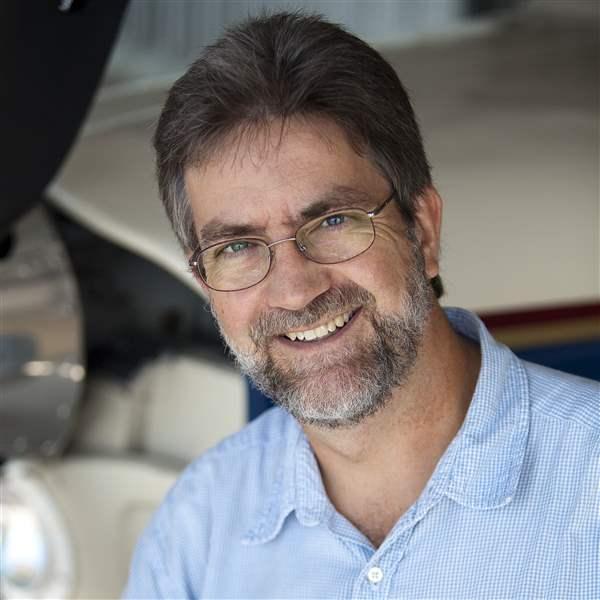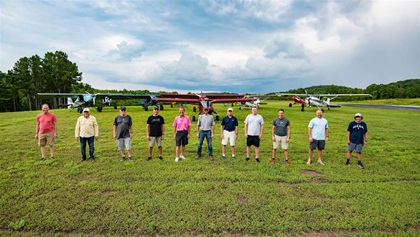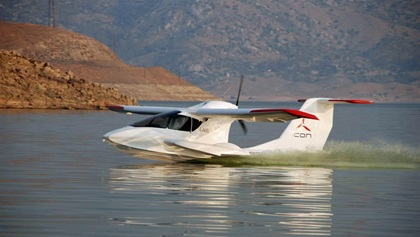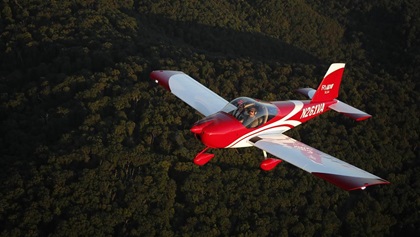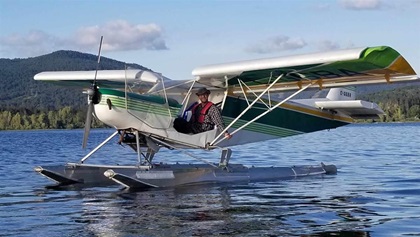Zenith STOL CH 701: STOL on the farm
Builder finds Zenith LSA to be a perfect fit, and fun
Fit for the farm
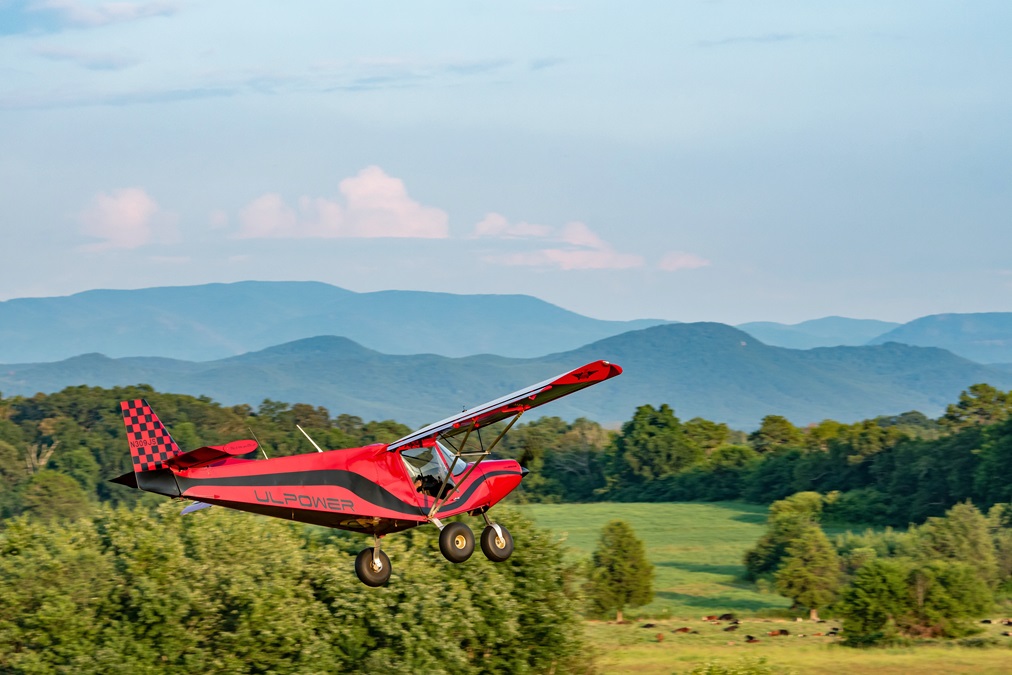
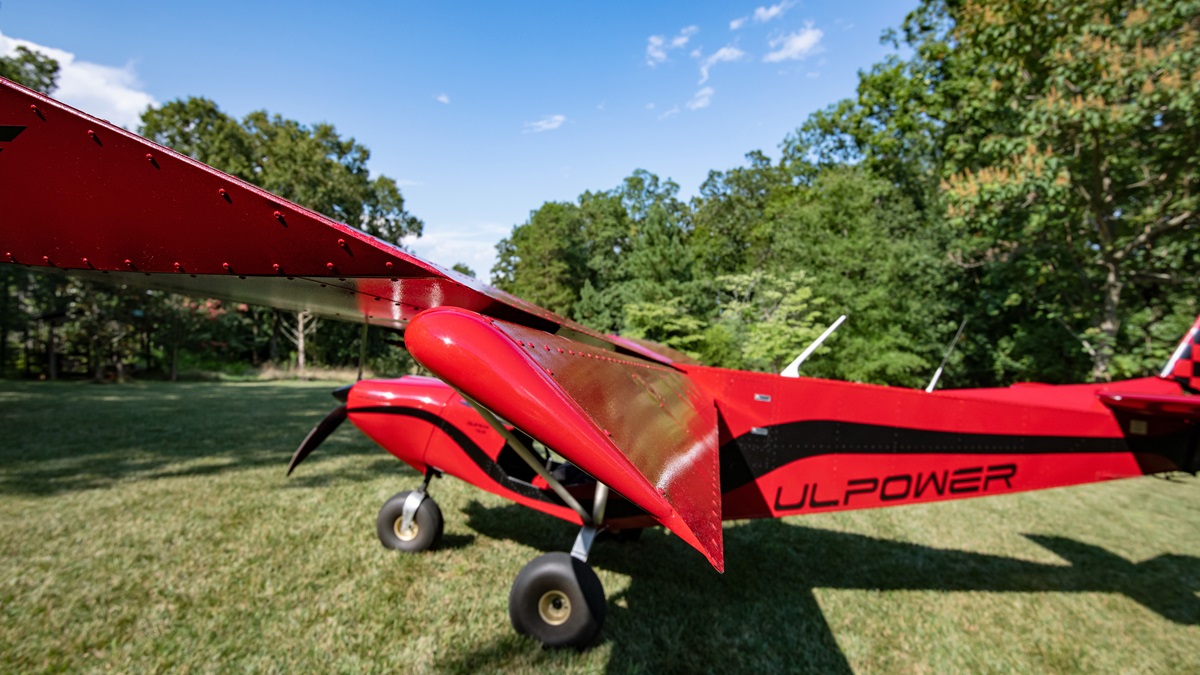


Early on, they were afraid of the airplane,” he said. “Once they got used to it, they could cause some trouble by not getting out of the way. If I have to put it down with [the cows], I can’t count on our cows moving.”
His neighbors don’t mind the overflights, either. “I’ve never heard anything negative from the neighbors,” he said. When he sees neighbors below, he’ll fly over and honk the horn, and waves are exchanged. Yes, Humberd installed an automotive horn under the cowl, and activates it by pushing one of the horn buttons, mounted on each side of the Y-shaped control stick in the center of the cockpit.
“I’ll never build another airplane without a horn. I have a lot of fun with that,” he said. “It’s not loud, it’s just enough to have fun with.” Its playful beeps encourage people to look up, and it complements the bright yellow smiley face that’s been on the bottom of the fuselage since the Zenith was completed.
Humberd chose to build so he could get exactly what he wanted, and fit was a primary factor in choosing a short takeoff and landing aircraft. The airplane had to fit in Humberd’s workshop; it had to be able to operate from his 350-foot, downhill runway; and it had to fit Humberd’s 5-foot, 10-inch frame. While other Zenith Aircraft STOL designs have adjustable seats, the light sport 701’s are fixed to the airframe. “It’s one of those deals that you either fit or you don’t,” he said. “It fit me like a glove.” Oh, and it had to fit his budget, too.
He received his STOL CH 701 kit in April 2016; the Super 701 moniker is Humberd’s because of his engine choice—a four-cylinder, 130-horsepower, air-cooled UL Power 350iS. He also calls the airplane his Sky Jeep. “We finished our house in 2017, and I finished the airplane in 2018. Ninety percent of this thing happened between midnight and daylight.” His construction window came after working the farm all day, and family time in the evening. “I enjoyed [building] but I found out real quick I’m not 20 anymore,” the 43-year-old laughed.
Many days, the farm is his aerial playground. Humberd farms 400 acres, raising row crops—soybeans, wheat, and corn—in addition to beef cattle. When crop fields are empty and there’s standing water, he’ll water ski. He can have fun flying for an hour or more and hardly leave the property.
His runway is just 20 miles west of the southern Appalachians. At 4,224 feet, Big Frog Mountain is the tallest nearby peak, looming above the Ocoee River. “That’s kind of my go-to spot,” Humberd said. “It’s cool to be able to fly for 10 or 15 minutes and get to where you can’t see a house.” It’s a year-round destination; fall provides the autumn colors, although winter can be touchy. “If you can catch a snow over there with just the right light, it’s amazing. My favorite is early spring, when everything is coming back to life.” Spring is also best for seeing wildlife, before it’s obscured by foliage.
Humberd built his shop in 2002, and the family later lived there while building a house next door. “My intention was to use it to build hot rods and work on farm equipment,” he said. The ceiling is high and the door is 24 feet wide, to fit a combine harvester. But the 701’s 27-foot wingspan requires several back-and-forth motions to move the airplane through the narrower door.
When it came time to choose an engine, UL Power was a natural for Humberd, who has a preference for air-cooled engines. He and his father operate several German-built Deutz tractors powered by air-cooled diesels. “It’s what I grew up with, and what I know,” he said. “It’s worked really well for us.” And the aircraft engine is modern, with fuel injection and FADEC.
The biggest construction challenge was the cowling, as none were commercially available for the 130-horsepower engine at the time. “That was a learning experience for me. I had never touched the composites world at all. There’s a learning curve, for sure.” After taking an Experimental Aircraft Association composites class in Atlanta, he wrapped the engine in plastic and put it on the airframe, using it as a template for the cowling. It took three tries to get the desired result. “I’m not afraid to try something new—I get that from my dad,” Humberd said.
To settle on a panel design, he printed out full-sized pictures of various avionics and laid them out on the actual panel, Clecoing it into the fuselage for evaluation. “I played with that for a good while,” he said. “As a first-time airplane builder it probably worked out better than I deserved.” Humberd ended up with a GRT Avionics Horizon HX EFIS as his primary display; a GRT Mini-X with backup battery as secondary (normally displaying the engine monitor); a Garmin GTR-200 com radio; an Appareo Stratus ESG ADS-B Out transponder; and a SkyRadar ADS-B receiver. “It’s more capable than I am. It has all the chart screens and approaches that you can think of,” he said. “It’s overkill—it’s maybe a lot of overkill. I chose it mostly because it fit.”
Built at home






Humberd increased the maximum gross weight by 150 pounds above the factory numbers, requiring a recalculation of the airframe’s G limits. He installed several Zenith upgrade options, including extended range fuel tanks, LED lighting, streamlined struts, and outward-domed bubble doors—the latter for increased elbow room and improved visibility. He also added a custom-made, 3-gallon header tank.
His builder’s log, required by the FAA to document construction, is a hardbound photo book consisting of daily progress pictures, and Humberd said the FAA inspectors from the Nashville Flight Standards District Office loved it. But he never recorded his hours worked for the two-year project.
He enjoyed the building experience. “Zenith has been really good to work with,” he said, and the UL Power engine has been easy to install, operate, and maintain. Anyone could build such an airplane, he added. “It’s not out of reach for anybody. It’s about budgeting and making it work.”
He earned his private pilot certificate at nearby Collegedale Municipal Airport, finishing just before he started building the kit.
Humberd’s wife, April Humberd, helped at various points during the build. “We’re outdoors people,” she said. “It’s a way to enjoy nature from a different point of view. It’s definitely a fun adventure. I know it means a lot to Jon, so it means a lot to us.”
She said she helped a lot with riveting and rustproofing. “People say he has a ton of patience, and I laugh,” she laughed. “He is stubborn and determined. He is not patient.”
First flight was August 31, 2018, and after flying off the required hours, his daughter Joslyn Savannah became his first passenger (the video is on YouTube and it’s really cute; search for “Sky Jeep 1st Passenger”). Joslyn, who started kindergarten this fall, has not yet noticed that the airplane’s tail number combines her birthday and initials.
Humberd has flown the airplane about 350 hours. Locally he flies by himself, or with a group of local STOL pilots (see “Meet the STOL Bandits,” p. 54). A flight to Gainesville, Texas, in March for the Lonestar STOL Competition is his longest cross-country so far. He cruises at 90 to 95 mph. “The 701 is a draggy airplane and the fuel burn quickly increases when going above about 90 mph,” he said. But flying around locally at no more than 60 to 65 mph, fuel burn is less than 3 gallons per hour.
“I just like to fly. If I can push it out of here and get up in it, that’s what I like to do—even if it’s just for an hour around here.”
Getting started
Flying wasn’t really a dream for Humberd when he constructed the shop, although he was flying radio-controlled aircraft at the time. Around 2010, he purchased an Ultraflight Lazair ultralight, flying it from a smaller strip on the farm. It got him hooked on low-and-slow flying. After rats nested in the ultralight, ruining the fabric, he decided to move into something all metal—and with a nosewheel to keep the tail off the ground, so that problem could not recur.
“I wanted something that would take the place of the ultralight and let me fly around with a passenger,” and the Zenith filled the bill. And it’s a lot quieter than the twin-engine ultralight with straight-pipe exhausts.
On June 22, 2020, Humberd damaged the Zenith’s left wing when it hit a fencepost after straying from the center of his taxiway, while taxiing back to the shop with the nosewheel off the ground. He decided to replace the wing. “Stuff happens,” he said. “It cost me a month. That’s a lot of work to do in a month.” But a downdraft paint booth in the basement, originally designed for hot-rod work, sped painting of the new wing. “I think the takeaway is that if you’re going to fly and play, you’re going to beat something up.”
Humberd plans to install a three-blade electric constant-speed propeller with a new spinner. He’s also thinking seriously about building a three-place Zenith STOL CH 750 SD (Super Duty) so that he, his wife, and their daughter can fly together.
Zenith’s STOL CH 750 can be built with a 1,320-pound maximum gross weight to qualify as a light sport aircraft, but the CH 750 SD has a design gross weight of 1,900 pounds that Humberd probably would increase to 2,050, in part to compete in a higher class at some STOL contests.
If that happens, however, don’t expect Humberd to part with his Super 701—it’s too much fun to fly and too economical, burning about half the fuel “for the same fun factor,” he said. That means a new hangar’s probably in his future, as well.
Email [email protected]
Spec Sheet
Zenith Aircraft STOL CH 701
Kit price: Low $50,000s | Price as tested: About $80,000
Specifications
Powerplant | UL Power 350iS, 130 hp
Recommended TBO | 1,500 hr
Propeller | Whirlwind ground adjustable 3-blade
Length | 20 ft 11 in
Height | 8 ft 7 in
Wingspan | 27 ft
Wing area | 122 sq ft
Wing loading | 9 lb/sq ft
Power loading | 8.5 lb/hp
Seats | 2
Cabin width | 3 ft 4 in
Cabin width, bubble doors | 3 ft 8 in
Empty weight, standard kit | 580 lb
Empty weight, as built | 700 lb
Max gross weight, standard kit | 1,100 lb
Max gross weight, as built | 1,250 lb
Useful load, standard kit | 520 lb
Useful load, as built | 550 lb
Payload w/full fuel, as built | 388 lb
Max takeoff weight | 1,250 lb
Max landing weight | 1,250 lb
Fuel capacity, standard kit, ext range tanks |
24 gal (23 gal usable)
144 lb (138 lb usable)
Fuel capacity, as built w/header tank |
27 gal (26 gal usable)
162 lb (156 lb usable)
Oil capacity | 3.5 qt
Baggage capacity | 50 lb
Performance
Takeoff distance, ground roll | 50 ft
Takeoff distance over 50-ft obstacle | 200 ft
Rate of climb, sea level | 1,200 fpm
Max level speed, sea level | 110 mph
Cruise speed/endurance w/45-min rsv, std fuel (fuel consumption)
@ 70% power, best economy | 90 mph/ 4.5 hr
6,500 ft | (5 gph/30 pph)
Max operating altitude | 12,500 ft
Landing distance over 50-ft obstacle | 200 ft
Landing distance, ground roll | 80 ft
Limiting and Recommended Airspeeds
VX (best angle of climb) | 35 mph
VY (best rate of climb) | 60 mph
VA (design maneuvering) | 71 mph
VFE (max flap extended) | 63 mph
VNO (max structural cruising) | 99 mph
VNE (never exceed) | 110 mph
VS1 (stall, clean) | 29 mph
For more information, contact kit manufacturer Zenith Aircraft Company, 1881 Airport Road, Mexico, Missouri 65265; 573-581-9000.
All specifications are based on manufacturer’s calculations. All performance figures are based on standard day, standard atmosphere, sea level, gross weight conditions unless otherwise noted.
